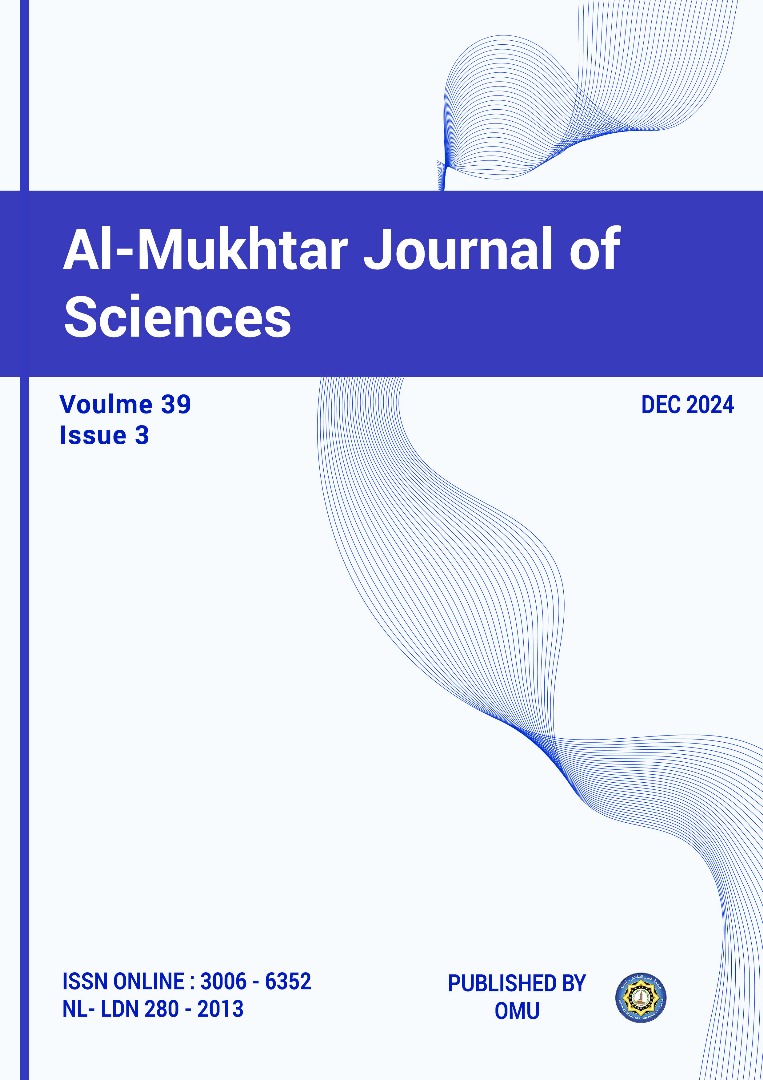Study of Bacterial Contamination in the Operating Room and Newborn Intensive Care Unit: Effects of the Predominantly Used Antibiotics at Sabratha Teaching Hospital
- Authors
-
-
Halemah M. Alashoury
Department of Medical La-boratory Sciences, Faculty of Medical Technology, Wadi Alshatii University, LibyaAuthor -
Khalid Othman
Department of Infection Control , Sabratha Teching Hospital, Sabratha, LibyaAuthor
-
- Keywords:
- Antibiotic resistance, Intensive Care Unit, Nosocomial infection, Operating room, Staphylococcus epidermides
- Abstract
-
Contamination by bacteria in the operating room (OR) and newborn intensive care units (NICU) has continued to increase the incidence of nosocomial infections and a center point of multidrug-resistant (MDR) pathogens. This study was to examine the spread of bacteria isolated from inanimate surfaces in the operating room and neonatal intensive care units at Sabratha Teaching Hospital and find out the effectiveness of the most antimicrobial used. Methods: At the Sabratha Teaching Hospital in Sabratha, Libya, a cross-sectional, descriptive study was conducted in the OR and NICU from February to May 2024. A total of 22 swab samples were collected from high-contact environmental surfaces. Isolation, identification, and antibiotic sensitivity patterns were performed via standard techniques. Results: After 48 hours of incubation, (54.5 %) of the swabbed surfaces showed positive bacterial growth and 45.5% showed no bacterial growth, of which 25% had gram-positive bacteria and 75% had gram-negative bacteria. Staphylococcus saprophyticus 3 (25%) was the identified gram-positive bacterial isolate, and Klebsiella spp. 5 (55.5%) and Pseudomonas aeruginosa 4 (44.4%) were the probable gram-negative bacterial isolates. The antimicrobial susceptibility pattern of clinical pathogens tested Staphylococcus epidermides and Klebsiella spp showed similar patterns which were sensitive to most antimicrobials used, while Pseudomonas aeruginosa was highly resistant to Cotrimoxazole, Cefatoxime, Cefixitin, Ceftazidime, Ceftricillin, and Calvu amoxicillin. Conclusion: This study confirms the need for rigorous disinfection protocols and hand hygiene to reduce the spread of these pathogens in the OR and NICU.
- Downloads
-
Download data is not yet available.
- References
-
Alphons K S, Fortune T V, Haindongo E, Guillaume A Y. (January 2020). Bacterial contamination and antimicrobial susceptibility from the hands of health care workers (HCWs) and inanimate surfaces in the neonatal intensive care unit (NICU) at the Windhoek Central Hospital (WCH). Microbiology and Nature Volume 1, Issue 3 pages 83-95 ISSN 2664-388X https://doi.org/10.26167/x34y-rn94 .
Bhatta DR, Hosuru Subramanya S, Hamal D, Shrestha R, Gauchan E, Basnet S, Nayak N, Gokhale S. (2021 Dec;10) Bacterial contamination of neonatal intensive care units: How safe are the neonates?. Antimicrobial Resistance & Infection Control. (1):1-6.
Bhalla A, Drin D, Donskey CJ. (2007). Staphylococcus aureus intestinal colonization is associated with increased frequency of S. aureus on skin of hospitalized patients BMC. Infect Dis.; 7:108.
Ben Ashur A, El Magrahi H, Yousha E, Naser M, Mousa A, Atia A, Abuagela M, Abdulwahed E, Jerbi Rehab, Alwaseea N, Ahmed F, Alaqeli E. (2022;). Bacterial Contamination of Neonatal Intensive Care Unit. Khalij J Dent Med Res. 6(2):134-143.
Bobo, L. D., & Dubberke, E. R. (2010). Recognition and prevention of hospital-associated enteric infections in the intensive care unit. Critical care medicine, 38(8 0), S324.
Chiguer M, Maleb A, Amrani R, Abda N, Alami Z. (2019). Assessment of surface cleaning and dis-infection in the neonatal intensive care unit. Heliyon. Dec 1;5(12): e02966.
Cura C, Ozen M, Kara AA, Alkan G, Cetin ES. (2016) Jan 1. Health care–associated infection sur-veillance in a tertiary neonatal intensive care unit: A prospective clinical study after moving to a new building. American journal of infection control.;44(1):80-4.
D’Alessandro D, Fabiani M, Appolloni L. (2021). Microbial Environmental Pollution in ICUs: Re-sults, Trends, and Suggestions from a Long-Lasting Surveillance. Atmosphere. (9):1174.
Darge A, Kahsay AG, Hailekiros H, Niguse S, Abdulkader M. (2019 Dec;12). Bacterial contamina-tion and antimicrobial susceptibility patterns of intensive care units’ medical equipment and inanimate surfaces at Ayder Comprehensive Specialized Hospital, Mekelle, Northern Ethiopia. BMC research notes. (1):1-8.
Ekrami AR, Kayedani A, Jahangir M, Kalantar E, Jalali M (2011). Isolation of common aerobic bacterial pathogens from the environment of seven hospitals, Ahvaz, Iran. Jundishapur J Mi-crobiol.4 (2): 75-82.
Elramli A, Agouri S, Almoghraby R, Akarem A, Alemam H. (2023). Prevalence of Multidrug Re-sistant Bacteria in Intensive Care Units and Operation Theatres at different Hospitals in Lib-ya. 7th Libyan International Conference on Medical, Applied, and Social Science. Alq J Med App Sci.;6(supp1):eLICMAS ISSN 2707-7179.
Ensayef S, Al-Shalchi S and Sabbar M. (2009), Microbial contamination in the operating theatre: a study in a hospital in Baghdad, Eastern Mediterranean Health Journal15 (1). 14.
Esfahani, B. N., Basiri, R., Mirhosseini, S.M. M., Moghim, S., & Dolatkhah, S. (2017). Nosocomial infections in intensive care unit: Pattern of antibiotic-resistance in Iranian community. Ad-vanced Biomedical Research, 6.
Haque M, Sartelli M, McKimm J, Bakar MA. (2018), Healthcare-associated infections–an over view. Infection and drug resistance.; 11:2321.
Haque M, McKimm J, Sartelli M, Dhingra S, Labricciosa FM, Islam S, Jahan D, Nusrat T, Chow-dhury TS, Coccolini F, Iskandar K, (2020). Strategies to prevent healthcare-associated infec-tions: a narrative overview. Risk management and healthcare policy.; 13:1765.
Ingale HD, Kongre VA, Bharadwaj RS. (2017 Jul) A study of infections in neonatal intensive care unit at a tertiary care hospital. Int J Contemp Pediatr.; 4(4):1349-56.
Kajiyazdi M, Dasdar S, Kianfar N, Kaveh M. (2021) Jul;9. Nosocomial Infection Surveillance in Neonatal Intensive Care Units of Bahrami Children’s Hospital. Arch Pediatr. (3):e108840
Lawn JE, Kerber K, Enweronu-Laryea C, Cousens S. (2010) Dec 1,3.6 million neonatal deaths—what is progressing-- and what is not? In Seminars in perinatology (Vol. 34, No. 6, pp. 371-386). WB Saunders.
Lalami AEO, Touiler H, El-Akhal F, Ettayebi M, Benchmesi N, Maniar S, Bekkari H (2016). Mi-crobiological monitoring of environment surfaces in a hospital in Fez city, Morocco. J. Mater. Environ. Sci. 2016; 7 :( 1):123-30.
Mbanga J, Sibanda A, Rubayah S, Buwerimwe F, Mambodza K (2018). Multi-Drug Resistant (MDR) Bacterial Isolates on Close Contact Surfaces and Health Care Workers in Intensive Care Units of a Tertiary Hospital in Bulawayo, Zimbabwe. Vol 27(2): 1-15, DOI: 10.9734/JAMMR/2018/42764.
Merzougui, L., Barhoumi, T., Guizani, T., Barhoumi, H., Hannachi, H., Turki, E., & Majdoub, W. (2018). Nosocomial infections in the Intensive Care Unit: annual incidence rate and clinical aspects. The Pan African Medical Journal, 30, 143-143.
M. Cheesbrough, (2009). Biochemical Tests to Identify Bacteria. In: District Laboratory Practice in Tropical Countries, Cambridge University Press, New York, pp: 45-58.
Mora R, Alanta, GA. (2001). Assessment of Thermal Comfort during Surgical Operation. ASHRAE Winter Meeting Program, January, 27-31.
Nseir S, Blazejewski C, Lubret R, Wallet F, Courcol R, Durocher A.( 2011 Aug 1). Risk of acquir-ing multidrug-resistant Gram-negative bacilli from prior room occupants in the intensive care unit. Clinical microbiology and infection.;17(8):1201-8.
Okon KO, Osundi S, Dibal J, Ngbale T, Bello M., Akuhwa RT. (2012) Bacterial contamination of operating theatre and other specialized care unit in a tertiary hospital in North eastern Nigeria. Africa Journal Microbiology Research, 6(1): 3092- 3096.
Rochford C, Sridhar D, Woods N, et al. (2018). Global governance of antimicrobial resistance. Lancet,; 391:1976–1978.
Sales VM, Oliveira E, Célia R, Gonçalves FR, de Melo CC. (2014). Análise microbiológica de superfícies inanimadas de uma Unidade de Terapia Intensiva ea segurança do paciente. Re-vista de Enfermagem Referência. (3):45-53.
Shiferaw T, BeyeneG, Kassa T, Sewunet T. (2013) Bacterial Contamination, Bacterial Profile and Antimicrobial Susceptibility Pattern of Isolates from Stethoscopes at Jimma Univ Specialized Hospital. Ann Clin Microbiol Antimicrob, 12: 39.
Suleyman G, Alangaden G, Bardossy AC. (2018 Jun;20) The role of environmental contamination in the transmission of nosocomial pathogens and healthcare-associated infections. Current in-fectious disease reports. (6):1-1.
Tacconelli E, Sifakis F, Harbarth S, et al. (2018). EPI-Net Cmbacte-Magnetg. Surveillance for con-trol of antimicrobial resistance. Lancet Infect Dis; 18: e99–e106.23.
Tajeddin E, Rashidan M, Razaghi M, Javadi SS, Sherafat SJ, Alebouyeh M, Sarbazi MR, Mansouri N, Zali MR. (2016 Jan 1). The role of the intensive care unit environment and health-care workers in the transmission of bacteria associated with hospital acquired infections. Journal of infection and public health.;9(1):13-23.
Weinstein RA, (1998). Nosocomial infection update. Emerg Infect Dis; 4:416 20.
Weinstein MP, Limbago B, Patel J, Mathers A, Campeau S, Mazzulli T, Eliopoulos GM, Patel R, Galas MF, Richter SS, (2018), M100 performance standards for antimicrobial susceptibility testing. Clinical & Laboratory Standards Institute.
Yusuf BJ, Okwong OK, Mohammed A, Abubakar KS, Babayo A, Barma MM, Ibrahim S, Sulaim-an AI, Hafiz H, Bello ZS (2017). Bacterial contamination of intensive care units at a tertiary hospital in Bauchi, Northeastern Nigeria. American Journal of Internal Medicine.;5(3):46.
Yusuf JB, Okwongo OK, Mohammed A, Abubakar KS, Babayo A, Barma MM, Ibrahim S, Sulaiman AI, Hafiz H, Bello ZS (2017). Bacterial Contamination of Intensive Care Units at a Tertiary Hospital in Bauchi, Northeastern Nigeria. American Journal of Internal Medicine. Vol. 5 (3), , pp. 46-51. Doi: 10.11648/ j. ajim.20170503.13.
- Downloads
- Published
- 2024-12-31
- Issue
- Vol. 39 No. 3 (2024)
- Section
- Articles
- License
-
Copyright (c) 2024 Halemah M. Alashoury, Khalid Othman (Author)

This work is licensed under a Creative Commons Attribution-NonCommercial 4.0 International License.
Copyright of the articles Published by Almukhtar Journal of Science (MJSc) is retained by the author(s), who grant MJSc a license to publish the article. Authors also grant any third party the right to use the article freely as long as its integrity is maintained and its original authors and cite MJSc as the original publisher. Also, they accept the article remains published by the MJSc website (except in the occasion of a retraction of the article).
How to Cite
Similar Articles
- Manal H. Algraiw, Huda H . Algriw, Omar I. Abusnena, Combatting Fatigue and Bone Pain: The Impact of Vitamin D Treatment in the General Practice Setting , Al-Mukhtar Journal of Sciences: Vol. 40 No. 1 (2025)
- Khaled Faiz, Jamal Gomati, Tariq Elhoony, Tariq Aldarat, Salah Eltaktouk, Muftah Elkhafifi, Ali Abokiash, Raouf Kwafi, Issa Abuzied, Iliopsoas Abscess: Presentation, Etiology, Treatment Options, and Outcomes: A Retrospective Analysis of 19 Cases , Al-Mukhtar Journal of Sciences: Vol. 40 No. 1 (2025)
- Osama Ahmadi, Mubarakah Abraheem, Aisha Aloshiby, Ibtisam Ahmadi, Areej EL-Sallak, Aram Elhashem, Hunaida Budajaja, Exploring the Role of Sociodemographic Factors in Influencing Dental Floss Knowledge and Practices among Adults in Sebha City, Libya: A Cross-Sectional Study , Al-Mukhtar Journal of Sciences: Vol. 40 No. 1 (2025)
- Jebril S. Elabidi, Asmaa F. Salih, Monia F. Abusarayi, Epidemiological and Clinical Characteristics of Pediatric Urinary Tract Infections in Benghazi, Libya: A Two-Year Retrospective Study , Al-Mukhtar Journal of Sciences: Vol. 40 No. 1 (2025)
- Naseralla J. Elsaadi Suliman, Sara I. El Fallah, Factors Influencing Postoperative Hospital Stay Following Colorectal Cancer Resection , Al-Mukhtar Journal of Sciences: Vol. 38 No. 3 (2023)
- Ghamela S. S. Ali, Fouziyah Jabullah, Salmi Boujaylah, Areej Alkasih, Abdullah Alshamikh Abdullah, Epidemiological Criteria and Management of Pediatric Inpatients with Community-acquired Pneumonia at Tobruk Medical Center/Libya , Al-Mukhtar Journal of Sciences: Vol. 39 No. 3 (2024)
- Nusieba A. M. Ibrahim, Yahya S. E. Mansour, Antibiotic Prescribing Treatment for Acute Gastroenteritis and Respiratory Illnesses among Children in Al-Bayda, Libya: A Cross-sectional Descriptive Study , Al-Mukhtar Journal of Sciences: Vol. 39 No. 3 (2024)
- Esmaiel I. F. Saad, Designing an Inhibitor Molecule to Combat Cancer through the Inhibition of Mutant PI3K (P110 α) Subunit Protein , Al-Mukhtar Journal of Sciences: Vol. 38 No. 4 (2023)
You may also start an advanced similarity search for this article.

















